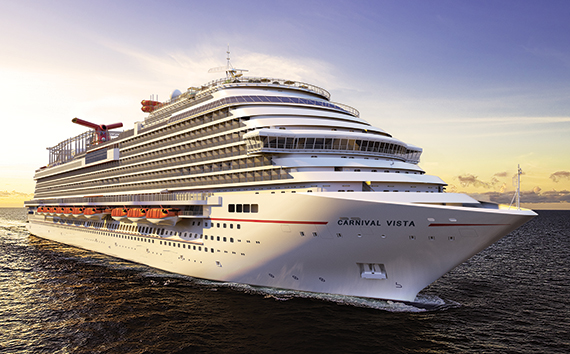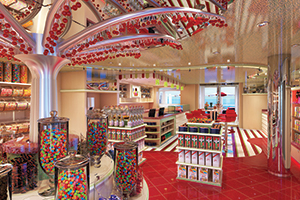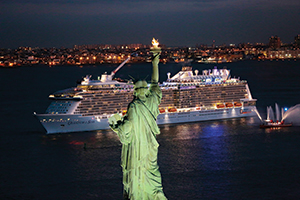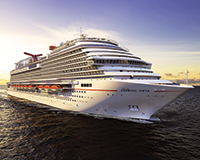 It is easy to forget, in light of its tragic maiden voyage, that Titanic was originally famed for being the most luxurious cruise liner ever built. The great and good paid handsomely to travel on the “unsinkable” ship – £870 (an eye-watering £71,778 today) for a parlour suite and small private promenade deck.
It is easy to forget, in light of its tragic maiden voyage, that Titanic was originally famed for being the most luxurious cruise liner ever built. The great and good paid handsomely to travel on the “unsinkable” ship – £870 (an eye-watering £71,778 today) for a parlour suite and small private promenade deck.
Whatever their class, people wanted to experience a trip on the lauded liner. But, the fact is, as Charles Weeks, professor of marine transportation at the Maine Maritime Academy, says: “The average person today would be bored to tears on the Titanic.”
Back then the only distractions were playing cards, reading, socialising and sitting or promenading on deck taking in the sea air. There were no pools and no real shops. “First-class passenger wanting to purchase souvenirs would have found some for sale in the barbers,” says Ed Coghlan, historian with the Irish Titanic Historical Society. Not really “shoppertainment”.
Fast-forward 100 years and things could not be more different. Today no modern cruise liner is complete without an array of onboard entertainment and, of course, shopping.
With the popularity of cruising increasing every year – cruise revenue leapt from $24.9bn (£16.6bn) in 2009 to $37.2bn in 2014 with passenger numbers more than doubling from 10.5m in 2004 to 21.5m last year – there is a growing, captive audience. And the cruise liner companies are starting to react.
Quantum of the Seas, a state of-the-art cruise ship launched by Royal Caribbean last October, claims to “raise the bar with all-new experiences and entertainment on board”.
Costing $969m (£643m) and able to carry almost 4,100 passengers, the ship is so large it has themed neighbourhoods featuring boutiques, restaurants and bars, and the Royal Promenade, which hosts upmarket retailers including Kate Spade and Michael Kors, and a Britto Art Gallery.
And if shopping doesn’t appeal, there are whirlpools, a climbing wall, a basketball court, a zip wire that races diagonally down nine decks, a nine-hole golf course and West End shows such as Andrew Lloyd Webber’s Cats.
Rival operator Carnival Cruise Lines is also going big into retail this year. Last month it unveiled its newest ship, Carnival Vista, an $800m vessel that will carry close to 4,000 passengers. For the first time in Carnival’s 43-year history, the ship will feature shops spread across two decks.
 Vice-president of retail, William Butler, says: “Retail has grown quite a bit. When Carnival first started we had small souvenir gift shops, but we have become a true player in the duty-free retail sector. We carry anything from an incredible assortment of liquor and tobacco to some of the finest pieces of jewellery you have ever seen. It’s evolved substantially.”
Vice-president of retail, William Butler, says: “Retail has grown quite a bit. When Carnival first started we had small souvenir gift shops, but we have become a true player in the duty-free retail sector. We carry anything from an incredible assortment of liquor and tobacco to some of the finest pieces of jewellery you have ever seen. It’s evolved substantially.”
Leisure, too, has evolved and Carnival is claiming that Vista is its most innovative ship so far. “Carnival Vista will take cruising to new heights and introduce an exciting array of groundbreaking new features,” says the blurb.
Those features include the world’s first onboard IMAX cinema, the first onboard brewery, Skyride – an 800ft, suspended bike track – a 450ft long water tube slide, restaurants and spas: everything its 4,000 passengers could possibly wish for.
But as services onboard have grown, so have the complications of serving the needs of guests and tenants.
“One of the most challenging components of onboard retailing is the logistics of getting merchandise on the ship,” says Butler. “I can’t take in daily shipments when the ship is at sea so everything we are due to sell needs to come in via a home port. I can’t afford to have a month’s worth on the ship either, because I just won’t be able to store it.”
The headache of dealing with the complexities of retailing on the high seas is handled largely by Starboard Cruise Ships, a third-party retail company responsible for the assortment and arrival of merchandise on ships.
Butler says Starboard, for which Carnival is the biggest customer, is given demographic breakdowns of passengers for each two-week cruise so that merchandise ordered can be correctly tailored to its audience. That level of planning means vital storage space is not wasted with unwanted goods.
All merchandise comes from Starboard’s centralised distribution centre in Miami, Florida. To ensure ships don’t run out of products, Ares Michaelides, Starboard’s executive vice-president, chief financial officer and chief operating officer, says there are a variety of integrated systems that assist the company in the forecasting, planning and replenishing of shops. “Given the global nature of our supply chain, replenishment is constant area of focus,” he says. “We have local fulfilment centres in various loading ports around the world and continue to expand this concept to optimise our supply chain.”
Shops vary in size between 4,000 sq ft and 6,000 sq ft and work on a contract basis specific to each brand with no set time length, instead of leases.
“Starboard negotiates with each vendor and there will be varying degrees of revenue shares, dependent on the retailer’s contract,” says Butler.
With the cruise market back on a growth path and more and more services being launched on bigger and more innovative vessels, there is plenty of opportunity to continue to expand the retail and leisure offer.
Butler reckons any retailer could work on water, but warns that the captive audience and finite space means that variety is essential.
“Having this captive audience gives us the opportunity to rotate merchandise so passengers can walk into the shop and see something new every day,” says Butler. “It’s important to have a variety of merchandise. We don’t want a duplication of everything you can buy at home.”
While a souvenir from the barbers or that fated necklace from Titanic may have been enough a century ago, 21st century passengers are more and more discerning. Will cruise liners become the floating Westfields of the future?
 The value of a cruise liner
The value of a cruise liner
A cruise liner is just like any other operation, with its value determined by the profit generated from the boat, writes David Harper, director of Leisure Property Services.
The majority of income comes from accommodation, with additional revenue from bar sales, spa treatments, retail sales and paid-for activities. A number of liners offer “all-inclusive” packages, where only premium drinks and activities incur additional charges.
Operational costs vary depending on the location of the vessel, although staff costs are usually lower than in comparable hotel resorts.
The valuing of a cruise liner varies from a holiday resort in three key ways.
First, there is usually a land component to real estate, but with a ship this usually significant element does not exist. Second, the economic life of a cruise liner is generally much lower than a more traditional building, which affects the capitalisation rate applied to such investments.
The third element is additional operational costs in running a cruise liner, including fuel and docking charges, as well as repairs and maintenance needed to protect the hull.
One significant advantage, however, is flexibility. A cruise ship is not confined to one geographical, political or economic environment. If underlying conditions change, the ship can move, taking advantage of more favourable conditions elsewhere.
We have seen cruise liners used exclusively as floating hotels, especially at one-off sporting events such as the FIFA World Cup or the Olympics, as they can provide an essential short-term solution to an undersupply problem. The issue for the owner in such circumstances is whether they generate enough income to justify taking them out of their usual trade routes.
Although not a standard investment, cruise liners certainly have operational advantages that resorts do not have, and provide a specialist sub-market, offering different levels of risk and security than more traditional hospitality products.











